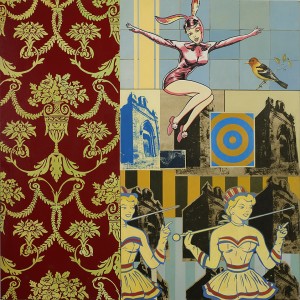
Allegories of the Human Figure, on exhibit at the Sandra Lee Gallery until Nov. 27, showcases a medley of attractive styles and a wide variety of ontological concerns by several artists.
Brett Amory and David Maxim investigate relationships between figure and environment. (Maxim, along with Randy Brennan, was added to the show just before its opening.) In Amory’s “Waiting #102,” part of his ongoing study titled Waiting, he interrogates the human form’s connections with artificial spaces. He blurs a solitary figure amid a murky urban environment, transporting us to a shadow world, a nowhere and everywhere place. Anonymous, box-like buildings drip and smear over each other, dominated by swaths of white or black. It is unclear if the painting’s elements emerge from or consume each other. Amory’s paintings offer an energy betraying neither joie de vive nor pessimism, but rather one of awe.
David Maxim’s paintings and sculptures accent their constituting materials. He sculpts androgynous figures out of painted canvas, string, and cardboard, creating aggressive textures. In one sculpture, “Stargazer,” a thin black board dotted with white pinpoints is attached to the arm of a figure leaning back in an appreciative gaze. The object of the subject’s gaze is an extension of its body, suggesting the figure is the environment. In thematic compliment to his sculptures, Maxim paints watercolor studies of them on drawing paper. The moisture wrinkles the paper and provides grooves through which the bright paint runs, giving the figures a dramatic sense of movement. Here he might be implying that the human figure is a representation of a representation, an image caught in a mirror facing a mirror.
Amory and Maxim avoid elaborating on the narratives inherit in the human figure; Jeff Palladini focuses on it. In his series “Subtraction,” Palladini’s figures are turned away from the viewer, their body and faces obscured. He then removes sections of paint from the works, leaving behind geometric shapes that reveal the wood boards serving as the paintings’ canvases. According to Palladini, he hopes to highlight the viewer’s projection of narrative onto these enigmatic scenes, but the conspicuous reduction of elements focuses attention not on the opaque figures but on Palladini’s method. In trying to invert our attention, he draws it to himself.
Clever and subtle, the paintings of Lawrence McAdams succeed where Palladini’s don’t. McAdams’s work explores the peculiar alchemy of figure and environment in narrative construction, seducing the viewer with deceptively simple scenes populated by equivocal details. One painting, “The Door,” depicts a young woman waiting by a door that could be either open or shut, wearing an indeterminate black garment and holding an indecipherable letter. The painting invites the viewer to speculate, but commits to no single interpretation; the young woman may be reading a love letter or a devastating communiqué.

Whereas the other exhibited artists explore broad themes, Sara Scribner and Michelle Jader offer case studies. Scribner paints scenes of irony and contrast in the vein of surrealism. Her painting, “Il Piove [translation: it’s raining],” depicts a young woman wearing a happy pink dress. She’s also wearing polar bear fur gloves, and presses against the clear plastic of her large umbrella (rain conspicuously absent), seemingly trapped. Jader experiments with the unique sense of depth and movement offered by painting on layered, semi-transparent acrylic boards; women suspended in air and in motion are the motif.
Perhaps the boldest of the bunch, Randy Brennan’s paintings experiment with representations of the human figure by using a pastiche of anachronistic and contemporary styles. In “Listen to My Circus,” a hand-painted Baroque wallpaper takes up about a third of the canvas. Opposite is a pop-art collage of church towers, majorettes, and a woman in a bunny suit in mid-leap. Like Amory and Maxim’s work, this spectacle of value-laden aesthetics equivocates the figure and its environment. But Brennan’s inclusion of the wallpaper implies that the painting itself is a costume.
Allegories of the Human Figure runs until November 27 at the Sandra Lee Gallery at 251 Post St. in San Francisco.
